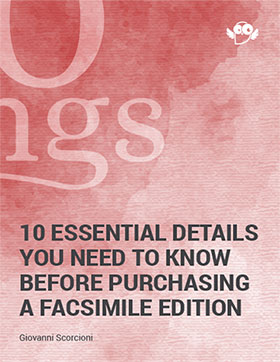What exactly is a facsimile edition? Why is it so expensive? How can I avoid frauds? Read on, and you’ll find out!

Whether for scholarly purposes or for pure personal pleasure, the function of a facsimile is to come as close as possible to the original document it replicates.
With such a high bar being set, the price of these beautiful editions are often correspondingly high.
Buyers need to make an informed decision in their purchasing process, as choosing the wrong edition could entail a great deal of frustration and disappointment.
After reading, you’ll know what to expect from the edition of your choice.
In this PDF you will find 10 things you need to know before purchasing a high-quality facsimile edition, and you’ll learn:
- First, what is a facsimile?
- Is it a full or partial facsimile?
- Has the facsimile got the original binding?
- Is the facsimile hand-bound?
- What kind of support is the facsimile produced on?
- Gold: is it real or fake?
- Is this the first time the manuscript is reproduced in facsimile? If not, what’s the difference to previous versions?
- What kind of printing technique was employed to print the facsimile?
- Does it have a commentary volume? In which language(s)?
- Is the facsimile you’re going to purchase new, like new or used?

